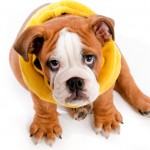Written by Senior Editor Peter Gehr
Some of the best puppy holistic dog care tips are very simple. First of all, prevention is the best cure. If your dog is getting the right exercise regimen in order to keep him/her fit and stimulated by regular walks, runs and play, chances are that he/she will then be ready for a good healthy meal. If you are supplying your pet with a balanced and appropriate diet, then you are providing the best preventative medicine available for your puppy.

Best Puppy Holistic Dog Care Tips
If you do not provide the exercise and diet that a dog needs and your animal becomes lazy, obese and inactive, then you have become a problem pet owner, and, frankly, you ought to be ashamed. Having said that, I feel better, but, even better yet, you can change and your pet can benefit from that change. Get off the couch and onto the street and down to the park, beach, river, field, farm, boardwalk, wherever it is that you have access and let your dog be a dog by running and playing as the energetic creature he/she was created to be.
Best Puppy Holistic Dog Care Tips
Health is more than the absence of disease. Health is a state of optimal well-being.” Optimal well-being is a concept of health that goes beyond the curing of illness to one of achieving wellness. Many of us have been brought up to believe that our health depends solely on the quality of the healthcare we receive. The truth is, your health is your responsibility. You are the only person who can make the lifestyle decisions that contribute to your well-being. You are the one who must take the steps to preserve your health and promote your wellness. Only you have the power to create wellness for yourself.
Elimination of the symptom is NOT the same as elimination of the disease. The fastest way to restore wellness is to stop putting into the body the things that have caused the physical problem to develop in the first place, and then give the body the nutrients it needs to repair and rebuild itself. The holistic approach treats the whole person, ignites the body’s internal healing force and stimulates the body’s natural abilities to heal itself. Ignite Your Body’s Internal Healing Force
Holistic dog health care is becoming a natural means for dog owners to ensure that their pets are as healthy as possible, living long, happy lives to the fullest. Perhaps the most important aspect for a dog’s health would be a unique blend of vitamins, minerals, and other nutrients to make sure the joints, organs, and digestive systems make work in harmony as well with the skin and coat being healthy. A diet of meat, vegetables, and whole grains without any processed foods or unnecessary fillers is usually recommended when following the holistic approach to dog care.
Using a variety of essential oils, plant extracts, herbs and flowering essences, people have treated numerous ailments and conditions over the past thousands of years. As of recently, these ancient healing practices have found their way into pet care and are now becoming increasingly popular as more and more dog owners are looking for safer, healthier, and less invasive alternatives to treating their pets.
Canine herbal remedies include calendula and chamomile for treating wounds, with chamomile used to give relief for respiratory complaints as well. To help your dog to recover from constipation or bowel disorders, you can try crushed flaxseed mixed with lot of water. For dry, itchy skin, oats are as soothing to a dog’s skin as they are to a human’s, and if your pup is having trouble sleeping, smelling some lavender may help them to relax and finally fall soundly asleep.
Be sure to do your homework before using any herbal concoctions on your dog. Some herbs and flowers can be harmful or even toxic to animals or people. Also, ask your veterinarian for their input and recommendations when it comes to holistic dog health and using all-natural remedies for their care.
Today there are an increasing number of veterinarians who are putting great stock in holistic dog health, making it a large part of their practice. A Vet who uses holistic dog strategies treats animals as a whole, rather than identifying a certain problem and prescribing one type of treatment to treat that specific injury or illness.
For instance, if your dog has suddenly come down with some sort of rash on his skin causing irritation, redness, itching, a possible infection, and some fur loss, a “regular” vet might send you away with an antibiotic to treat the skin infection as well as a topical ointment to deal with the itching.
A holistic veterinarian will place more emphasis on determining the cause of the rash as the source of the infection before prescribing those two remedies. With holistic care, the dog’s indoor and outdoor environment, his daily lifestyle, eating habits and nutritional intake are all taken into consideration before attempting to diagnose or treat the animal. Click here to visit the original source of this post
The best puppy holistic dog care tips are also of benefit to you, the dog owner. Regular exercise is much the same as providing a health care system that will keep your pet alive for much longer than one that has no exercise. For example, I was with a neighbor today who has a Corgi that looks like it is about to explode. This fat and inactive dog will soon die a painful death due to inactivity and poor diet. I know you love your dog, and I know you want to give it the very best attention you can provide. However, this does not include ice cream, beer, chocolate, candy, or no exercise.
A dog is a dog and can only eat what dogs are meant to eat. Additionally, dogs are created to run, jump, play, and exercise and without this in their life, you are creating a problem that will be both expensive (vet bills) and painful (watching a dog die prematurely). Be the best dog owner you can be by providing the best life you can offer which includes applying the very basics of best puppy holistic dog care tips. And, as stated in the beginning of this article, let that begin with regular exercise and a healthy diet.



















